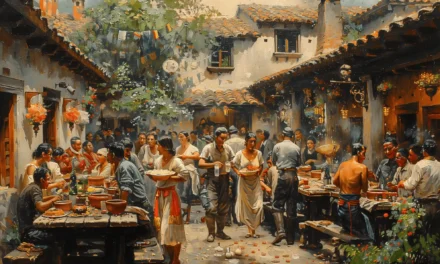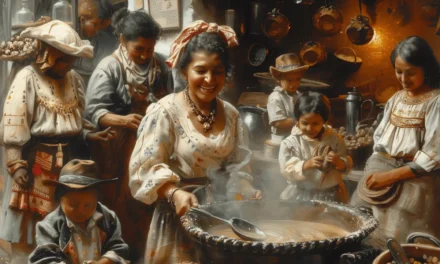“Arepa de Huevo” is like a flavor explosion waiting to happen. It’s a deep-fried arepa that’s filled with egg and other ingredients, giving it a unique texture and flavor that will make your mouth water. All the flavors in this dish come together to create a delicious mix that is sure to tantalize your taste buds with every bite! So why not give it a try and see for yourself why this iconic dish from the Caribbean Region in Colombia is loved by locals and visitors alike?
Something that is as traditional as salt and pepper in the Caribbean region is the timeless Arepa de Huevo of the street vendors. Whether in the port cities of Cartagena de Indias, San Jose de Costa Rica, or San Juan de Puerto Rico, you can guarantee that every corner of the main cities will have a street vendor slinging these delicious treats1.
Hugs From the Past: The Warm Flaky Pastry of Empanadas
Sephardi Jews in Spain and Portugal got creative during the Middle Ages when it came to special occasion meals and food to eat during the Sabbath. They developed a technique that opened up a whole new world of deliciousness – it involved crafting a pastry dough, then taking it for a swim in a delicious sea of meat or fish.
This delicious treat known as “empanadas” has been around for centuries, tracing its roots all the way back to Rabbinic literature. It’s like an ancient form of comfort food, a warm hug in the form of flaky pastry – the type of hug that just keeps giving!
From their humble beginnings in the pages of ancient history, empanadas have gone on to take the world by storm, becoming a beloved snack in Iberian-American countries. They have taken a journey to our modern plates, much like an intrepid explorer trekking their way through time and culture.
You could say that Arepa de Huevo is the distant cousin of the traditional empanada. They share many similar ingredients and techniques, but Arepa de Huevo has its own unique flavor.
Culinary Alchemy: The Origin Story of Arepa de Huevo
A staple ingredient in the Cartegena kitchen was lard by the end of the XVIII century and during the first half of the XIX century. It was whipped up by African enslaved women like a master chef in a gourmet kitchen, putting all other cooking oils to shame. This lard was so good at what it did, you could have sworn it was magic! It got sizzling in the pan and made anyone who tried it feel like they had been transported to foodie paradise.

Eggceptionally Delicious – The Debate Between the Arepa de Huevo and the Empanada de Huevo
Some things just have a way of being mysterious – like why in some parts of the world, folks call the same dish one thing, while in other parts, it has a totally different name. Take the classic Arepa de Huevo, for example. In some places, it’s known by this name, but in Cartagena, they call it an Empanada de Huevo.
People from Barranquilla and Cartagena can have some pretty heated debates, especially when it comes to traditional dishes like the Arepa de Huevo or the Empanada de Huevo. If we’re talking about an anonymous egg snack, then it’s almost like we’re talking about a friendly game of tug of war – everyone grabs an end of the rope and refuses to give in, each side convinced that their version is the only truth. And the truth is, no one really knows who’s right and who’s wrong.
The recipe in Cartagena is a culinary work of art, like a masterpiece! You can expect to find exactly one egg, and a savory blend of minced meat carefully chosen by the chef – a combination that’s so cuddly and cozy it will remind you of a delicious empanada snuggled up against your taste buds. On the other hand, the traditional recipes from the region are completely eggcelence without the extra ingredients. Just one egg sometimes is all it takes to create a meal that is simply eggstraordinary!
The Tale of the Secret Recipe: Unlocking Arepa de Huevo in Luruaco
Have you heard of the small picturesque village of Luruaco? It’s a hidden gem two hours from Barranquilla’s bustling city. This quaint place is known far and wide as the Capital of Arepa de Huevo.
It’s as if Arepa de Huevo has been around for so long; it’s like Grandma’s secret family recipe that’s been in the oven for a century! She stirs the pot with her stories from her youth and serves a delightful dish that has been handed down through generations. It’s an integral part of the culture and people in the local communities, and its roots go so deep you could probably trace it back a hundred years!
There is a tall tale that has been passed down from generation to generation about one crafty grandmother and her secret recipe. Apparently, this recipe was so good that it spread like wildfire throughout the region. People flocked from far and wide to get a taste of the granny’s special dish.
It’s like the recipe was a shining beacon of deliciousness, bequeathed to the people ages ago and still a source of prosperity and joy. People couldn’t get enough of this amazing culinary creation, and it continues to bring good fortune and cheer to this day!
For 30 years, the municipality has been like a giant, bubbling pot of culture and festivities, hosting the Arepa de Huevo Festival! It’s like a family reunion for the local community, with mothers and grandmothers proudly showcasing their beloved recipes. The party is hopping all day long with vibrant music, dazzling traditional dances, and plenty of good vibes to go around.
The municipality gives a prize on 3 categories:
- Innovation in the form
- Innovation in the filling
- Traditional recipe
The recipe & the technique:
- The classic recipe is made using milled corn or cornmeal and a little bit of “Queso Costeño” (a unique type of cheese from the region), salt, and water. With these ingredients, you make a dough.
- You give a round form to the dough and fry it to inflate the center. For this step, it is very important to have the cooking oil at a high temperature.
- Once is ready (the dough floats and is inflated on the center), you remove it from the cooking oil and put it in a recipient.
- Immediately you open a tiny hole and fill the dough with 1 egg (some people cover the hole with a little bit of dough for aesthetics).
- You put it in the cooking oil at a lower temperature than the first time until the egg is cooked.
In theory, the process is simple; however, it requires perfecting the technique for the best result.
- JorgeSAM[↩]




